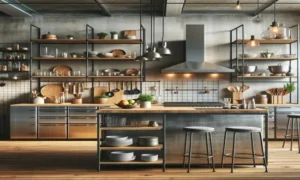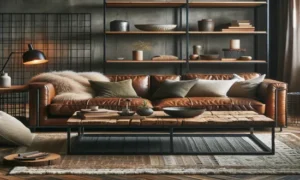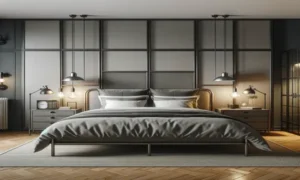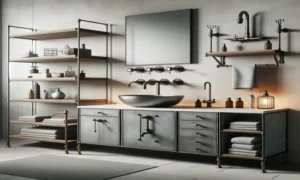Introduction
When we talk about industrial furniture, we are referring to a design trend that emerged from the vast, open spaces of urban lofts, commonly found in former industrial areas and warehouses. This style, which initially served the practical needs of industrial workspaces, has over time transcended these boundaries and found a permanent place at the heart of modern interior design. The essence of industrial furniture lies in its rugged simplicity, use of raw materials and functionality that originally served factory workers and environments. With an aesthetic that combines rustic and modern, this furniture not only evokes a sense of history and resilience, but also adapts surprisingly well to a variety of domestic settings. The growing popularity of this furniture in the contemporary interior design scene is a testament to its versatility, durability and ability to add a unique charm to any space, from the most stripped-down loft to the most welcoming home.
History and Origin
Industrial design as we know it today has its roots in the Industrial Revolution, a period when mass production and industrial efficiency began to shape the world. However, it wasn’t until the 20th century that industrial aesthetics began to influence interior design, particularly in urban lofts and industrial warehouses. Originally, these large spaces were intended for industrial production, with large windows for natural light, high ceilings to accommodate heavy machinery, and an architecture that prioritized function over form.
Over time, many of these industrial structures were abandoned or relocated, leaving behind vast, underutilized spaces in urban landscapes. In the 1960s, artists and creatives began to reimagine these warehouses and factories as homes and studios, attracted by the affordable rents and abundance of space and light. It was this repurposing that gave rise to the concept of the “loft” as we know it today.
The furniture that occupied these spaces followed the same design logic: it was robust, functional and devoid of unnecessary ornamentation, reflecting the practical needs of the industrial environment. Over time, these pieces of furniture gained appreciation for their unique aesthetics and were integrated into contemporary interior design. The simplicity, durability and inherent history of these pieces made them a popular choice among those looking for a style that combined the old with the new, the functional with the aesthetic, transforming the way we think about furniture and space in the context of modern urban life.
Features of Industrial Furniture
Industrial furniture is known for its distinctive characteristics that reflect a combination of robustness, simplicity and functionality. These pieces are often made from raw, durable materials that not only ensure longevity but also give them a striking, personality-filled look. Materials such as metal, wood and concrete are the most commonly used, each bringing its own texture and aesthetic to the piece. Metal, often left in its raw or minimally treated form, evokes a sense of strength and durability. Wood, whether reclaimed from old structures or used in its more natural, rustic form, adds an element of warmth and history. Concrete, with its robust texture and minimalist appearance, complements other materials perfectly.
Industrial furniture design is typically functional and minimalist, avoiding unnecessary ornamentation. This practical approach stems directly from its origins in industrial work environments, where efficiency and utility were paramount. The simplicity of the design not only serves a functional purpose, but also creates a visually appealing and timeless aesthetic.
The color palette for industrial furniture tends to be neutral and subdued, with tones ranging from the black and gray of metal to the natural brown of wood. These neutral colors reinforce the versatility of the furniture, allowing it to easily integrate into a variety of environments and decorative styles. This chromatic neutrality also helps to highlight the natural beauty of the materials used, emphasizing their textures and unique characteristics.
Transition from Loft to Home
The transition of industrial furniture from loft spaces to conventional homes and apartments is a fascinating phenomenon that reflects a shift in interior design preferences. Initially confined to the large, open spaces of lofts, characteristic of gentrified urban areas, the industrial style has begun to gain popularity among a wider audience, admiring its unique aesthetics and functionality.
This growing popularity can be attributed to a number of factors. Firstly, the versatility of industrial furniture makes it an attractive option for a variety of spaces, large and small. Its simplistic design and clean lines allow it to effortlessly integrate into a variety of décor styles, from modern to rustic. Additionally, the robustness and durability of the materials used, such as metal and wood, ensure that this furniture will stand the test of time, both in terms of functionality and aesthetics.
The unique aesthetic of industrial furniture has also played a crucial role in its transition into mainstream homes. Its distinctive look, which blends raw elements with a modern twist, offers an appealing alternative to traditional furniture. This style draws attention to the beauty of simplicity and raw materials, creating spaces that are both contemporary and full of character.
With the rise in interest in custom interior designs and spaces that reflect individuality, industrial furniture has found a special place in modern homes. It offers a way for homeowners to express their personality while maintaining a welcoming and functional environment. As it continues to evolve, it is likely that this furniture will maintain its relevance and popularity in the world of interior design.
Practical Applications in Domestic Environments
Industrial furniture, with its versatility and characteristic aesthetics, can be found in almost every room of the house, adding a touch of style and functionality. Here are some ways to incorporate it into different spaces:
- Kitchen: In this space, open metal and wood shelves are perfect for storing dishes and ingredients, offering easy access and a rustic touch. Kitchen islands with metal frames and wood or concrete tops can serve as a functional center for food prep and quick meals. Combining industrial furniture with modern appliances creates a balance between old and new.

- Living room: Leather sofas with metal frames, coffee tables with recycled wood tops, and metal shelving are excellent choices for this space. They bring a sense of robustness while maintaining comfort. For a balanced decor, pair them with soft fabrics and rugs to add warmth to the space.

- Rooms: Simple and functional metal or wood headboards, metal cabinets with glass doors and metal nightstands are ideal for adding an industrial touch without overwhelming the space. Industrial style light fixtures can be used for directional lighting.

- Bathrooms: Metal sinks, metal-framed cabinets, and open wooden shelving are great for adding an industrial touch to your bathroom. Opt for faucets and accessories with a metallic finish to complete the look.

When decorating with industrial furniture, it’s important to maintain a balance between raw and cozy elements. Mix textures and materials, such as metal, wood, and soft fabrics, to create a welcoming space. The key is to keep things simple and allow each piece to stand out, ensuring that the space doesn’t feel overwhelmed.
Benefits and Sustainability
One of the main benefits of industrial furniture is its remarkable durability. Built to withstand the harsh conditions of industrial environments, these pieces of furniture are made to last, using materials such as durable metal, robust wood and concrete. This durability means fewer replacements over time, which is both economically advantageous and environmentally responsible.
Furthermore, industrial furniture is notable for its ease of maintenance. Its simple design and the nature of the materials used allow for easy cleaning and maintenance, without the need for special treatments or care. This makes industrial furniture a practical and efficient option for everyday use.
From a sustainability perspective, industrial furniture often uses recycled or recyclable materials. Reclaimed wood from old buildings, repurposed metal, and the use of low-impact concrete are all examples of sustainable practices in the design of industrial furniture. This approach not only reduces waste and environmental impact, but also adds an element of history and unique character to each piece. The increasing use of sustainable materials and conscious manufacturing processes in industrial design reflects a larger trend toward environmental responsibility in the world of interior design.
Future Trends
As we move forward, industrial furniture will likely continue to evolve, remaining a popular choice for interior designers and homeowners alike. One emerging trend is the fusion of industrial style with other decorative styles, such as Scandinavian or bohemian, creating a hybrid aesthetic that combines the best of many worlds. This approach allows for greater flexibility and personalization in interior design.
Another future trend is an increased focus on sustainability. As environmental awareness grows, industrial furniture is expected to focus even more on recycled, sustainable and responsibly sourced materials. This could include the use of innovative technologies to create more environmentally friendly materials and production processes that reduce the carbon footprint.
Additionally, with the growing demand for multifunctional, small-space furniture solutions, especially in urban environments, industrial furniture will likely adapt to offer more compact and versatile options. This could include modular designs and multifunctional pieces that maximize space and efficiency.
In short, the future of industrial furniture looks promising, with a continued evolution towards more sustainable, versatile and integrative designs, while maintaining its unique identity and timeless appeal.
Conclusion
Throughout this blog post, we’ve explored the rich history, distinctive characteristics, and unparalleled versatility of industrial furniture. From the inherent robustness and functionality of its design, to the way it seamlessly adapts to a variety of domestic settings, these pieces of furniture have proven to be more than just a passing trend. They’re a timeless expression of style and practicality, bridging the aesthetics of the industrial past with contemporary needs. As we continue to witness its evolution, it’s clear that industrial furniture holds a special place in the world of interior design, from the urban loft to the comfort and personality of the home.
